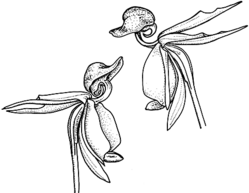Common name: Large Duck Orchid
Caleana major R.Br. APNI* 
Description: Terrestrial herb.
Leaf usually prostrate, narrow-lanceolate, to 12 cm long and 8 mm wide, often spotted.
Inflorescence to 40 cm high, wiry, 1–5-flowered. Flowers reddish brown to shiny purple (rarely greenish with dark spots). Sepals and lateral petals to 15 mm long, narrow-linear, often channelled. Lateral sepals obliquely erect; dorsal sepal and lateral petals clasping or reflexed against the column wings. Labellum claw prominently curved supporting the inverted and erect lamina; lamina to 8 mm long and 6 mm wide, with a polished, smoothly sculptured appearance bearing a solitary, strap-like appendage. Column scoop-shaped.
Flowering: September–February
Distribution and occurrence: Widespread, usually forming colonies of only a few plants in sclerophyll forest, coastal or swampy shrubland and heathland, often in sandy or gravelly soils; chiefly on the coast and tablelands, inland to the Guyra and Braidwood districts.
NSW subdivisions: NC, CC, SC, NT, CT, ST
Other Australian states: Qld Vic. Tas. S.A.
Text by P. Bernhardt, updated by M.A.M. Renner (1 Nov 2019)
Taxon concept: Flora of NSW 4 (1993)
APNI* Provides a link to the Australian Plant Name Index (hosted by the Australian National Botanic Gardens) for comprehensive bibliographic data
***The AVH map option provides a detailed interactive Australia wide distribution map drawn from collections held by all major Australian herbaria participating in the Australian Virtual Herbarium project.
|


